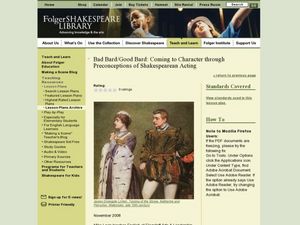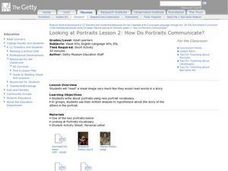Curated OER
The Squeaky Door
Young readers distinguish between the sounds for short vowel e and long vowel e. They are introduced to the vowel patterns that comprise long vowel sounds, with emphasis on /ea/. They practice reading and spelling a variety of words that...
Curated OER
The Artist As Entrepreneur: You Say Tomato, I See Tomato
Young scholars compare phone negotiations with in person negotiations to identify the non-verbal communication that is produced in face-to-face meetings. They practice forms of non-verbal communication by reciting the alphabet and...
Curated OER
That/Which/Who Game
Third graders play a game to practice speaking the target language (English). They are divided into teams. One student from each team sits at the front of the room. One student reads a clue (in English)-there team receives one point for...
Curated OER
Friends
Students complete vocabulary activities about friends. For this vocabulary lesson, students introduce themselves in a ball game format and discuss the topic of friends. Students complete a worksheet with related vocabulary and read a...
Curated OER
Strange Stories
Students complete activities about new words. In this new words instructional activity, students complete activities to teach vocabulary and practice new words. Students read a story and add in the new words.
Curated OER
Looking at French Decorative Arts: The Quest for True Porcelain
Students study the effects of production and consumption of goods on French society during the porcelain period. In this history activity students research the trade history of porcelain from Asia.
Curated OER
One Word Substitution 20
In this online interactive vocabulary skills learning exercise, students match the 10 vocabulary terms in the word bank to the appropriate definitions. Students may submit their answers to be scored.
Curated OER
Writing Application: The Canterbury Tales
Students read stories from The Canterbury Tales by Geoffrey Chaucer and create their own tale. In this writing applications instructional activity, students read the tales and analyze the specific details that Chaucer use. Students work...
Curated OER
Three Part Dialogue
Eighth graders write a three part dialogue as part of an effective memoir. In this three part dialogue lesson, 8th graders are given two parts of a dialogue and emotions that accompany the words. Students then create the...
Curated OER
Bad Bard/Good Bard: Coming to Character through Preconceptions of Shakespearean Acting
Students practice their own acting skills. In this Shakespeare activity, students participate in choral readings and reenact scenes from The Taming of the Shrew. Students then discuss the difficulties of Shakespearean acting.
Curated OER
Anger Management
Students discuss anger triggers and how they know they are getting angry. In this anger lesson plan, students discuss anger vocabulary and how to calm themselves down.
Curated OER
Hip Hop Dance Cut Outs
Students research visual art by examining art on-line. In this art expression lesson, students discuss the history of art after researching information on the Internet. Students view images on the web which feature physical movement...
Curated OER
Alphabetic Acting
Students recognize the short vowel a in written and spoken language. Through matching activities, they discriminate the short vowel /a/ from other vowel phonemes. Students associate the phoneme with its letter representation and identify...
Curated OER
How Do Portraits Communicate?
Students read a visual image very much like they would read words in a story. They write about portraits using new portrait vocabulary. They, in groups, use their written analysis to hypothesize about the story of the sitters in the...
Curated OER
Family Communication Style
Eighth graders explore the different ways that families communicate with each other. After a lecture/demo, 8th graders generate a list of relationships that might benefit from practice in the art of conversation and communication.
Curated OER
Silly Siggy
Students recognize the short /i/ sound in spoken and written words in this lesson. They say a tongue twister which emphasizes words with the short /i/ sound. They then listen to the book "Liz is Six" and identify the words in the story...
Curated OER
What's the Deal With Nature?
Twelfth graders read the poem "Crossing the Swamp" and "Pipefish" then discuss the use of metaphor in each poem. They write a poem about how they feel about school using a nature metaphor.
Curated OER
Crying Students
Students recognize the phoneme for the short vowel a in written and spoken language. Through a variety of activities, they discriminate the short vowel /a/ from other phonemes. Students associate the phoneme with its letter...
Curated OER
Iiizzy is Iiicky Sticky!
Students answer a series of questions about the different sounds that the letter I makes. They observe a picture about a girl and the letter I. They practice a tongue twister with the different sounds of I. They practice writing the...
Curated OER
Finding Common Ground
Fifth graders write at least three descriptive qualities about themselves on a note card. The teacher then reads the qualities to the class, and the class members try to determine which student is being presented. They use the cards to...
Curated OER
Post Office Stamps
Students research and analyze how communication has changed over time. They chart communication developments on a timeline, and create commemorative stamps depicting forms of communication.
Curated OER
Crayola® Model Magic® Colored Courtly Characters
Students create a "Noh"-style mask, based on Japanese Noh theatre masks. They experiment with different colors of modeling clay and explore ways to show facial character.
Curated OER
Noh Theater
Students explore the roles in Noh drama and the significance of Noh masks while creating their own version of a Noh play in this High School lesson adaptable for either the Language Arts or Theater classroom.
Curated OER
Understanding Symbols
Learners examine two Buddhist images. Using Venn Diagrams, students compare and contrast the images in an effort to decode their meanings. Learners are then introduced to Buddhism through a story of Buddha.























